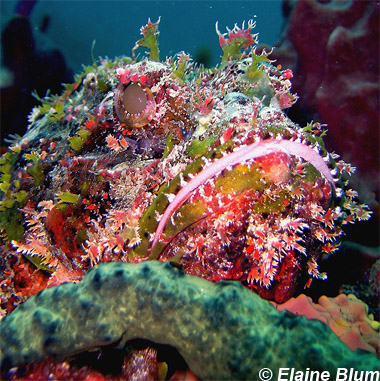
Scorpaena plumieri
These reef-dwelling fish are great at camouflage, using their mottled coloring and texture to sneak up on smaller fish and crustaceans and swallow them whole in one fast gulp. From short face and big eyes, to stout caudal (tail) fin, they are usually seven to 14 inches long, and are named for the colorful markings on their pectoral fins, including a dark area with white spots. Because there are venomous spines in their dorsal fins, caution should be used if handling these fish, or when diving in rocky reef areas.
Order – Scorpaeniformes
Family – Scorpaenidae
Genus – Scorpaena
Species – plumieri
Common Names
English language common names of this species includes spotted scorpionfish, gurnard, lion fish, Pacific spotted scorpionfish, prickly hind, St. Ann’s bay, and stinging grouper. Other common names include aniquim (Portuguese), aniquim-beatriz (Portuguese), aniquim-de-pedra (Portuguese), arracacho (Spanish), baetinha (Portuguese), beatinha (Portuguese), beatriz (Portuguese), biriati (Portuguese), brantfes kòrá (Papiamento), brantkonofeshi (Papiamento), briati (Portuguese), escoprión rascacio (Spanish), escorpión negro (Spanish), madara-fusakasago (Japanese), mamangá (Portuguese), mangangá (Portuguese), moreiati (Portuguese), moriati (Portuguese), niquim (Portuguese), niquim da-pedra (Portuguese) niquim de-pedra (Portuguese), peixe-escorpião (Portuguese), peixe-pedra (Portuguese), rascacio (Spanish), rascacio multicolor (Spanish), rascacio negro (Spanish), rascana (Spanish), rascasio (Spanish), rascasio negro (Spanish), rascaso (Spanish), rascasse noire (French), sapo chaznete negro (Spanish), sarrão (Portuguese), skorpena cetkowana (Polish), and veneno (Spanish).
Importance to Humans
Spotted scorpionfish are caught as incidental bycatch throughout its range primarily on hook and line, in traps, and shallow water trawls. The flesh is marketed fresh for human consumption. There has been at least one reported case from the Virgin Islands of ciguatera poisoning from the human consumption of the flesh of this fish. This species does pose some risk to human due to the presence of venomous dorsal spines which release venom upon penetration. It is used as a deterrent against predators as well as humans. Although it is not generally fatal to humans, immediate medical treatment should be sought for victims. Divers should take care to avoid contact with scorpionfish and to be careful where they stick their hands.
Conservation
The spotted scorpionfish is not listed as endangered or vulnerable with the World Conservation Union (IUCN). The IUCN is a global union of states, governmental agencies, and non-governmental organizations in a partnership that assesses the conservation status of species.
> Check the status of the spotted scorpionfish at the IUCN website.
Geographical Distribution
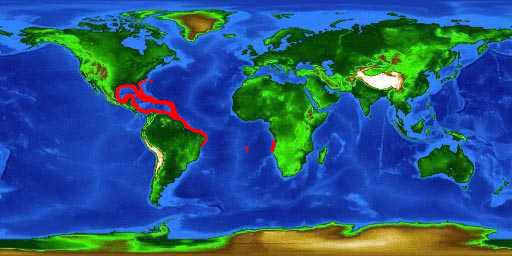
The spotted scorpionfish is found in the western Atlantic Ocean from Bermuda to Massachusetts, and the northern Gulf of Mexico to southern Brazil. Its range in the eastern Atlantic Ocean is around Ascension and St. Helena.
Habitat
This species is most often found associated with shallow coral reefs and rocky areas and is moderately common from 16-180 feet (5-55 m) in depth. It typically lies motionless, camouflaged on the bottom substrate.
Biology
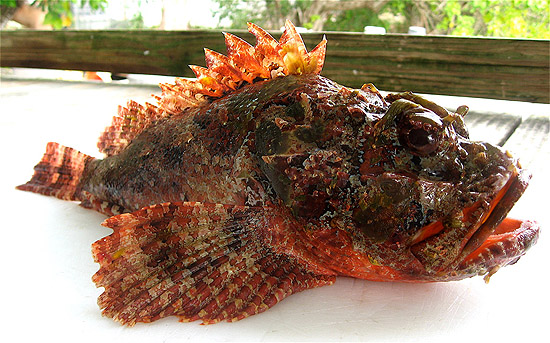
Distinctive Features
The spotted scorpionfish is a spiny-headed robust scorpionfish with a dorsal fin having 12 spines and 9 ½ soft rays (last split to base and counted as 1 ½) and the pectoral fin with 18-21 fin rays. Venom glands are associated with the dorsal fin spines for protection from predators. The suborbital ridge is formed by the infraorbital bones 2 and 3 with usually one to two spines respectively. There are fleshy plumes referred to as cirri over the eyes along with skin flaps around the chin and head. The occipital pit is well developed. The pectoral fins have broad bases and are fan-like in shape; the dorsal fin is continuous and deeply notched; and the caudal fin is truncate. The mouth is terminal with the maxilla reaching past the eye.
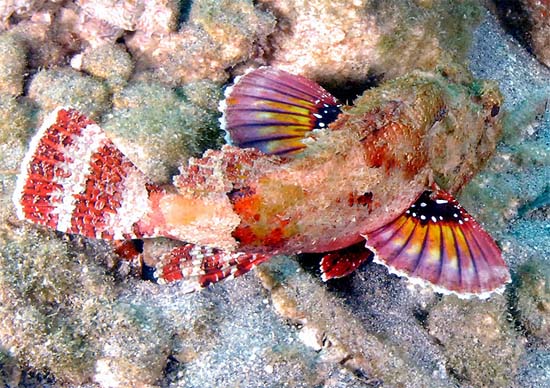
Coloration
Coloration of this species is variable, ranging from shades of brown or black on a paler background with the area before the caudal fin appearing abruptly paler. The head is mottled with dark markings while the ventral surface is often orangish or reddish in color. The fins have bands or dark blotches on a pale background often with patches of green. The caudal fin has dark bars at the base, middle and near the end. The inside of the pectoral fins have large white spots or blotches on a black background. The pectoral fins are extended to display bright white spots when the fish is disturbed.
Dentition
The teeth of the spotted scorpionfish are small, arranged in narrow bands on the jaws, palatine, and vomer.
Size, Age, and Growth
As the largest and most common scorpionfishes in the Atlantic Ocean and Caribbean, the maximum reported length of the spotted scorpionfish is 17.7 inches (45.0 cm) total length (TL) however it is more commonly observed at lengths of approximately 7.1-14.2 inches (18.0-36.0 cm) TL. The maximum published weight of this species is 3.4 pounds (1.55 kg).
Food Habits
As ambush predators, the spotted scorpionfish uses camouflage to get within striking distance of prey. It feeds primarily on other fish and crustaceans, using its large mouth to create a vacuum and quickly suck in and swallow prey.
Reproduction
Scorpionfish are oviparous with females producing eggs that are transparent or greenish in color. During spawning, the eggs and sperm are released and float near the surface. Little else is known about scorpionfish reproduction.
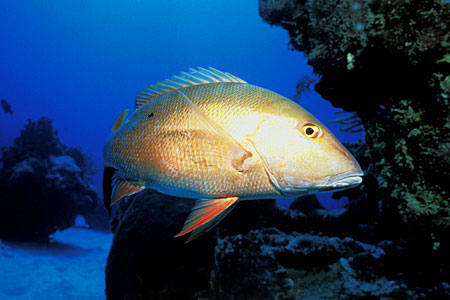
Predators
Documented predators of the spotted scorpionfish are snapper including the schoolmaster (Lutjanus apodus) and mutton snapper (Lutjanus analis) as well as sharks, rays, and moray eels.
Parasites
Parasites of the spotted scorpionfish include the digenic trematodes Neopecoelus scorpaenae and Helicometrina nimia.
Taxonomy
The spotted scorpionfish was originally described as Scorpaena plumieri by Bloch in 1789. Synonyms referring to this species in past scientific literature include Scorpaena plumieri plumieri Bloch 1789, Scorpaena plumierii Block 1789, Scorpaena bufo Cuvier 1829, Scorpaena scrofina Valenciennes 1833, Scorpaena rascacio Poey 1860, and Scorpaena albofasciata Metzelaar 1919. The family Scorpaenidae, the scorpionfish, consists primarily of marine species and includes many of the world’s venomous fish.
Prepared by: Cathy Bester